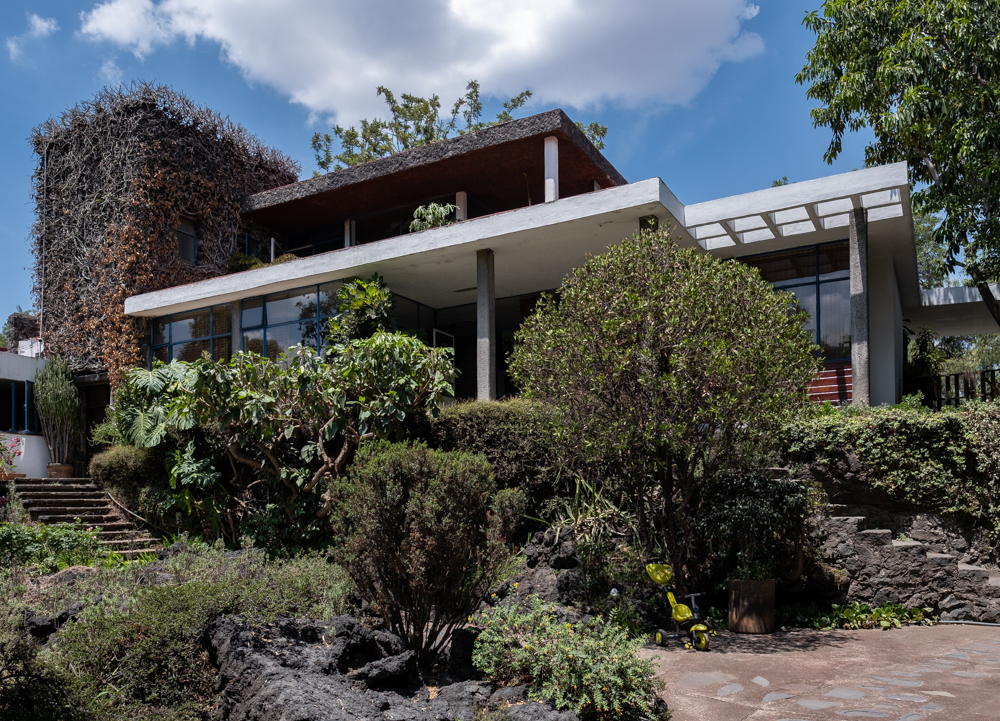Max Cetto / Pedregal
 I was finally able to visit the Max Cetto house and studio in Mexico City.
I was finally able to visit the Max Cetto house and studio in Mexico City.
Cetto designed the house for himself and family in 1949. It is located south of central Mexico City in Jardines del Pedregal de San Ángel. Luis Barragan saw the potential in the lava fields of the Xitle and in 1945 purchased purchased property with José Alberto Bustamante. Barragan then created a plan for Pedregal and began selling properties. Some of Mexico's greatest modern architects, like Francisco Artigas, Enrique Castañeda Tamborrell, José María Buendía, Antonio Attolini, Fernando Ponce Pino, Oscar Urrutia and Manuel Rosen constructed homes in Pedregal. However, the first to build was German émigré Max Cetto.
In his book (which is one of the best on the subject), Modern Architecture in Mexico, Cetto said... "Certainly it is not Barragan's fault that many of the houses in what is now the city's most exclusive residential area have not risen to the opportunity presented by the unusual characteristics of this natural site." He goes on to describe his own house as "appreciably smaller and simpler than its neighborhoods." In fact, Max's grandson said he requested a much smaller lot than what was normally offered in the Pedregal subdivision.
Image: Esther McCoy Papers via Smithsonian
Max Cetto was born in Germany to Italian parents in 1903. Educated in the progressive circles of Weimar Germany, he studied under Hans Poelzig and in 1926 he graduated as an engineer–architect. He left Germany due to the rise of Fascism and moved to San Francisco in 1938. He worked with Richard Neutra for a year on projects, including the Kahn House (1939). He then decided to settle in Mexico.
Since he was not a Mexican citizen he worked with Mexican architects for several years. Even after establishing his own office, Juan O'Gorman was the name of record on many of his projects. In 1947 he was granted Mexican citizenship but wasn't allowed to actually sign his own projects (including his own house) until 1952.
Cetto is noted for combining a respect for nature with a Modernist approach. His home is one of the best examples of this. His wife Catarina is responsible for the garden. The house is still owned by the Cetto family and Max's grandson opened his house up for the tour.
Image: Esther McCoy Papers via Smithsonian
A second level with an additional bedroom and a studio for Max was added in 1951.
The time Cetto worked with Richard Neutra must have had a big influence on him. The resemblance to the Neutra Kaufmann house is undeniable.
Image: Esther McCoy Papers via Smithsonian
Cetto's goal was to "...create, with the help of architecture, a balance between man and his environment."
The Clara Porset chairs are not in the house anymore, but that table in front of the fireplace and some of the dining chairs seen here are still there.
Image: Esther McCoy Papers via Smithsonian
Image: Esther McCoy Papers via Smithsonian
Coconut shells were used as a wall covering.
Image: Esther McCoy Papers via Smithsonian
Max designed the table and cabinet,
He also designed these light fixtures made of a sheet of glass and coat hanger wire.
The door leads to the stairs.
And what a staircase it is.
Image: Archivo Max Cetto, UAM Azcapotzalco, Mexico.
Cetto's former drafting studio
Image: Esther McCoy Papers via Smithsonian
The stone mosaic design is by Max but was certainly influenced by his good friend Juan O'Gorman. The symbols include the family's zodiac signs.
The back patio.
The family spent much of their time living outside of the house.
Image: Esther McCoy Papers via Smithsonian
This terracotta chiminea is original to the house.
Image: Esther McCoy Papers via Smithsonian

































